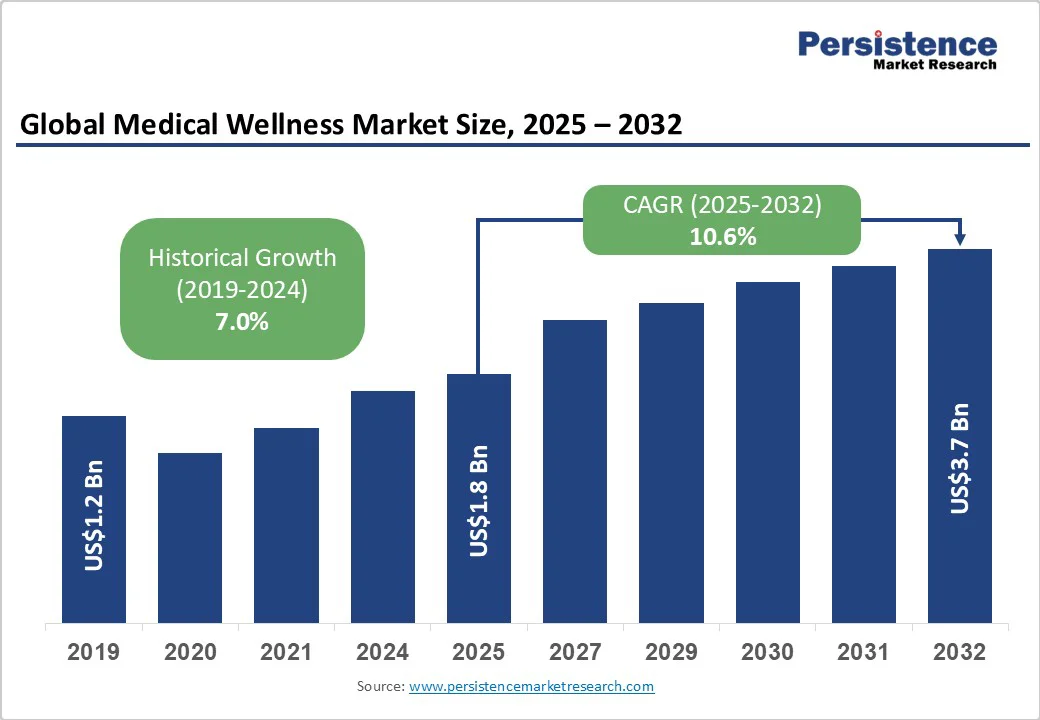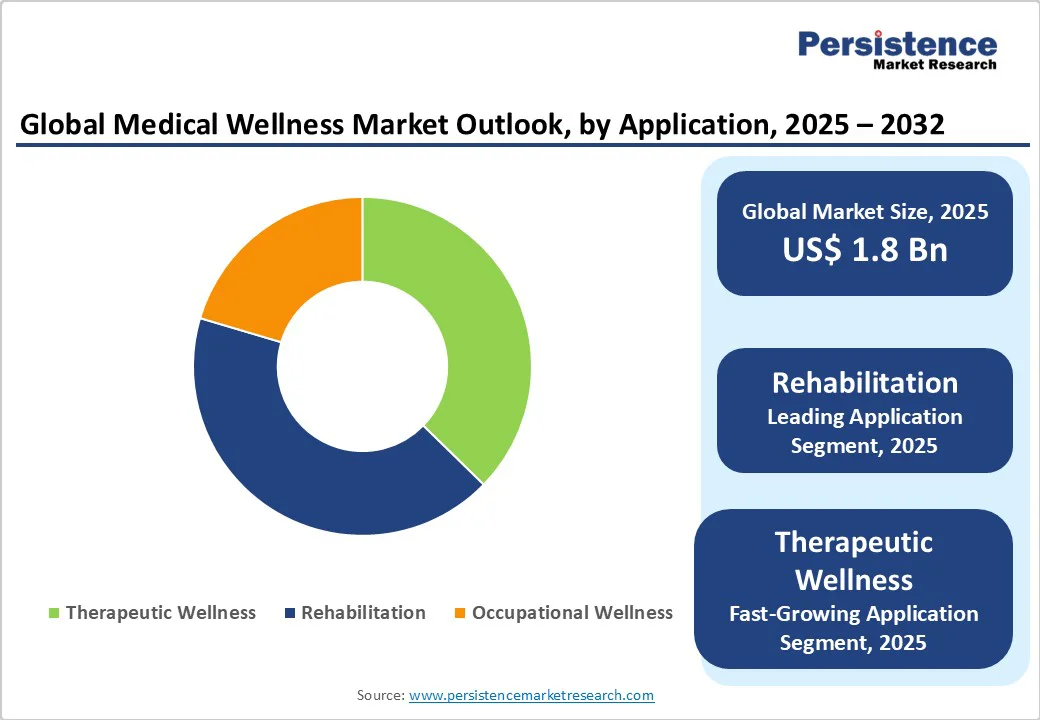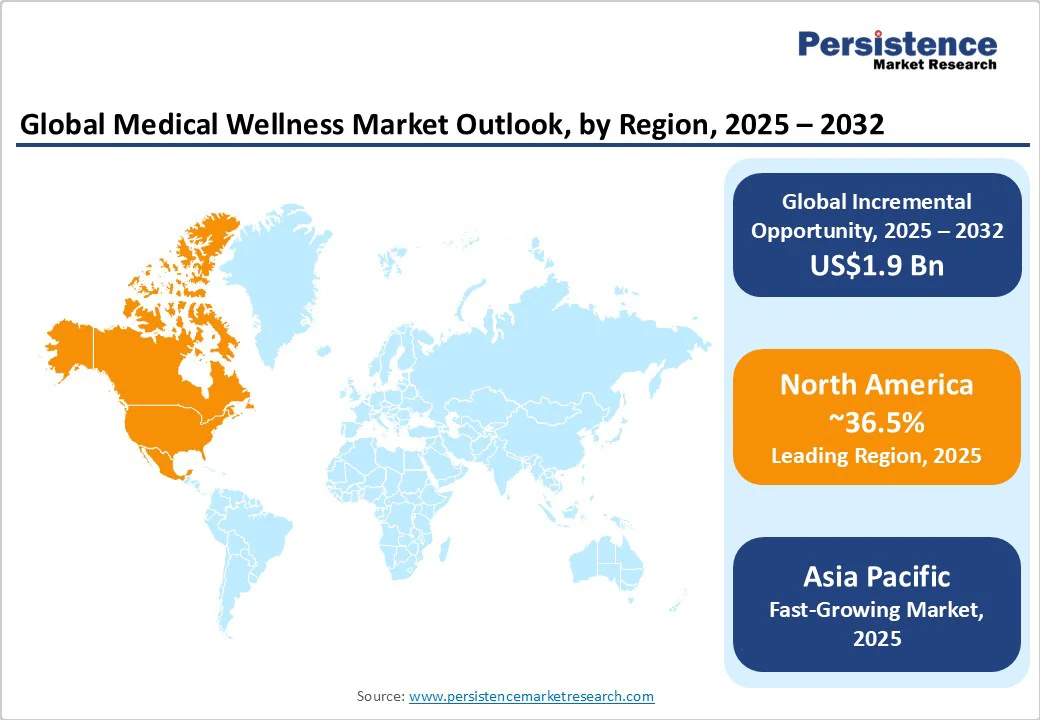ID: PMRREP18787| 185 Pages | 15 Oct 2025 | Format: PDF, Excel, PPT* | Healthcare

The global medical wellness market size is expected to reach US$1.8 billion by 2025. It is estimated to reach US$3.7 billion by 2032, growing at a CAGR of 10.6% during the forecast period from 2025 to 2032, driven by rising consumer demand for holistic health solutions that combine preventive care, mental well-being, and personalized treatments.
| Key Insights | Details |
|---|---|
| Medical Wellness Market Size (2025E) | US$1.8 Bn |
| Market Value Forecast (2032F) | US$3.7 Bn |
| Projected Growth (CAGR 2025 to 2032) | 10.6% |
| Historical Market Growth (CAGR 2019 to 2024) | 7.0% |

The medical wellness industry is increasingly adopting a holistic approach that encompasses both physical and mental health. This 360-degree model recognizes the interconnectedness of various wellness dimensions, including physical activity, nutrition, sleep, emotional well-being, and social connections.
For instance, modern executive checkups now integrate preventive medicine, high-tech diagnostics, lifestyle analysis, and emotional well-being into a single program, providing a comprehensive view of an individual's health. This approach enables personalized care plans that cater to the unique needs of individuals, fostering well-being and resilience.
The COVID-19 pandemic and other factors have drastically raised awareness of mental health, leading to a surge in demand for services such as meditation, mindfulness, and therapy. Studies have shown that mindfulness meditation can effectively reduce stress and improve psychological well-being, specifically during challenging times.
Online mindfulness-based interventions have also been found to soothe depressive symptoms and improve emotional regulation. This shift toward mental wellness has prompted healthcare providers to incorporate these practices into their services, reflecting a broad trend of integrating mental health into wellness strategies.
Some workplace wellness programs implement penalties for employees who fail to meet specific health targets, such as high insurance premiums for smokers or those with a high Body Mass Index (BMI). While such programs aim to encourage healthy behaviors, they can inadvertently penalize employees with chronic conditions or those facing socioeconomic challenges, leading to increased health disparities.
For instance, employees from low-income backgrounds may face greater challenges in achieving certain health benchmarks due to limited access to healthcare or healthy lifestyle resources. This approach can create a divide between healthy and unhealthy workers, potentially breeding a sense of inequity and resentment within the workplace.
Small businesses often face significant hurdles when attempting to establish on-site wellness programs. The costs associated with setting up and maintaining such programs can be prohibitive, especially when considering expenses such as staffing, medical equipment, and facility space.
The administrative burden of managing these programs can further overwhelm small business owners and HR personnel who already juggle multiple responsibilities. For example, a small company might require additional personnel or outsource management to ensure the program's effectiveness, further increasing costs.
A notable development in wellness tourism is Sweden's pioneering initiative, The Swedish Prescription, where doctors prescribe visits to the country as part of health and wellness interventions. This approach highlights the therapeutic benefits of Sweden's natural landscapes, outdoor activities, and culture, positioning travel as a proactive component of healthcare.
Such initiatives are changing the perception of wellness tourism, emphasizing its role in enhancing both physical and mental well-being, rather than merely serving as a luxury or leisure activity. This trend is gaining traction globally, with destinations such as Ujjain in India promoting holistic health practices, including yoga, Ayurveda, and meditation, in an effort to establish themselves as wellness hubs.
Lifestyle medicine is now adopting a multidisciplinary approach, integrating various healthcare professionals to provide comprehensive care. This collaborative model involves physicians, nutritionists, therapists, and other specialists working together to address the root causes of chronic diseases through lifestyle modifications.
For example, the American College of Lifestyle Medicine (ACLM) is hosting its annual conference, Lifestyle Medicine 2025, in Dallas-Fort Worth, bringing together thousands of clinicians and health leaders to discuss developments in the field of lifestyle medicine. Such gatherings facilitate knowledge exchange and fuel collaboration among diverse healthcare providers.
Medical spas are estimated to account for approximately 18.4% of the market share in 2025 as they blend aesthetic treatments with medical oversight, delivering both visible results and health benefits. Unlike traditional spas, medical spas offer services such as Botox, laser therapies, and regenerative treatments under the supervision of licensed medical professionals, ensuring both safety and efficacy.
For example, clinics such as SHA Wellness Clinic in Spain and Chenot Palace in Switzerland offer integrated wellness programs that encompass medical diagnostics, anti-aging therapies, and stress reduction treatments, attracting clients who seek beauty and health benefits.
Workplace wellness programs are poised for steady growth in 2025, targeting the rising demand for preventive health among employees and improving productivity, engagement, and retention. Companies are now integrating mental health counseling, fitness programs, nutrition coaching, and stress management workshops into employee benefit packages.
Adults are expected to hold a share of nearly 58.3% in 2025, as they are highly proactive in maintaining their health, managing stress, and preventing lifestyle-related diseases. This group often seeks services such as personalized fitness plans, nutrition counseling, and preventive screenings, as they balance their busy professional and family lives. Companies are customizing their services to meet the needs of adults by combining convenience and technology.
The geriatric population is a key focus because aging increases vulnerability to chronic conditions, mobility issues, and cognitive decline. Medical wellness services for older adults focus on preventive care, physiotherapy, cognitive health, and personalized nutrition programs to enhance quality of life. For example, Europe-based wellness centers deliver specialized anti-aging therapies, hydrotherapy, and medical screenings designed for seniors.
Rehabilitation is expected to capture approximately 42.3% of the market share in 2025, as it addresses the growing need for recovery services following injuries, surgeries, and chronic conditions. Modern wellness centers integrate physical therapy, occupational therapy, and post-surgical care to accelerate recovery while improving long-term functionality. The focus on personalized rehabilitation, often supported by digital health monitoring and AI-based progress tracking, ensures efficient outcomes, making it a core application in medical wellness.
Therapeutic wellness is surging steadily due to rising awareness of mental and emotional health and the demand for non-invasive, preventive interventions. Practices such as mindfulness, meditation, physiotherapy, and stress management are being integrated into mainstream healthcare and corporate wellness programs. This approach supports long-term health maintenance, reduces stress-related illnesses, and promotes overall well-being, thereby fostering steady adoption across diverse demographics.

In 2025, North America is expected to account for approximately 36.5% of the market share, driven by the convergence of healthcare, technology, and lifestyle. This integration is evident in novel models, such as KKR's in-office health clinic in Manhattan, which offers services including chiropractic care, physical therapy, cancer screenings, and mental health counseling, all accessible via an encrypted app. The clinic's emphasis on convenience and comprehensive care reflects a broad trend of integrating wellness into daily life.
Another key development is the rise of ‘med-cations,’ i.e., luxury health-focused retreats that combine wellness and medical diagnostics. For instance, SHA Wellness Clinic in Mexico provides programs such as ozone therapy and personalized health regimens, catering to affluent travelers seeking preventive healthcare experiences. Concierge medicine is also gaining popularity, especially in New York City, where high-net-worth individuals opt for personalized medical care that includes 24/7 availability and expedited specialist referrals.
Asia Pacific is experiencing a key transformation in medical wellness, propelled by a blend of traditional practices and modern healthcare developments. Countries such as Japan are integrating ancient wellness traditions into contemporary health practices.
For example, Japan's practice of Shinrin-Yoku or forest bathing is gaining recognition for its scientifically backed benefits, such as boosting immunity and reducing stress. This practice involves immersing oneself in a forest environment to improve well-being, highlighting the country’s commitment to holistic health approaches.
Asia Pacific is further embracing technological developments in health and wellness. There is a rising demand for wearable devices and at-home health diagnostics that allow consumers to track their health metrics conveniently. This trend is particularly pronounced in the region, where consumers are more inclined to purchase health-focused technology products. Premiumization is bolstered by the incorporation of AI that delivers increasingly personalized and holistic recommendations based on individuals’ own metrics and goals.
Europe is experiencing a dynamic evolution in medical wellness, characterized by a fusion of traditional therapies and new medical innovations. Switzerland and Spain are leading this transformation. In Switzerland, Chenot Palace Weggis delivers comprehensive health makeovers, including novel diagnostics, hydrotherapy, and Eastern medicine practices, attracting affluent clients seeking rejuvenation and longevity.
Spain's SHA Wellness Clinic in Alicante combines macrobiotic diets with therapies such as ozone and NAD+ infusions, catering to an international clientele focused on anti-aging and holistic health. In Italy, Palazzo Fiuggi integrates scientific development with classic Italian hospitality, providing treatments such as blood screenings and hydrotherapy in a historic setting. The spa emphasizes sustainability, using organic products and eco-certified materials, catering to the rising demand for environmentally conscious wellness experiences.

The global medical wellness market is characterized by a convergence of novel technology, personalized care, and strategic partnerships. Companies are focusing on integrating AI and data analytics to deliver proactive and preventive healthcare solutions.
This approach aims to shift the healthcare paradigm from reactive treatment to proactive wellness management. A few other players are engaging in collaborations with small-scale companies to provide comprehensive lab testing and personalized health insights.
The medical wellness market is projected to reach US$1.8 Billion in 2025.
Rising demand for preventive healthcare and surging awareness of mental well-being are the key market drivers.
The medical wellness market is poised to witness a CAGR of 10.6% from 2025 to 2032.
Integration of traditional practices with modern medicine and the emergence of medical spas are the key market opportunities.
Truworth Wellness, AsiaMedic Limited, and Naluri are a few key market players.
| Report Attribute | Details |
|---|---|
| Historical Data/Actuals | 2019 - 2024 |
| Forecast Period | 2025 - 2032 |
| Market Analysis | Value: US$ Bn |
| Geographical Coverage |
|
| Segmental Coverage |
|
| Competitive Analysis |
|
| Report Highlights |
|
By Service Type
By Age Group
By Application
By Region
Delivery Timelines
For more information on this report and its delivery timelines please get in touch with our sales team.
About Author